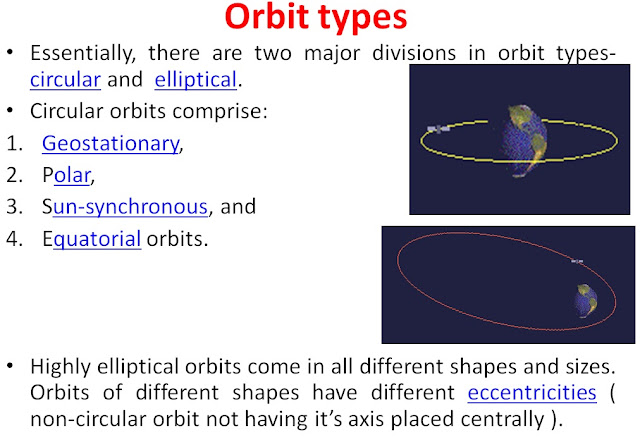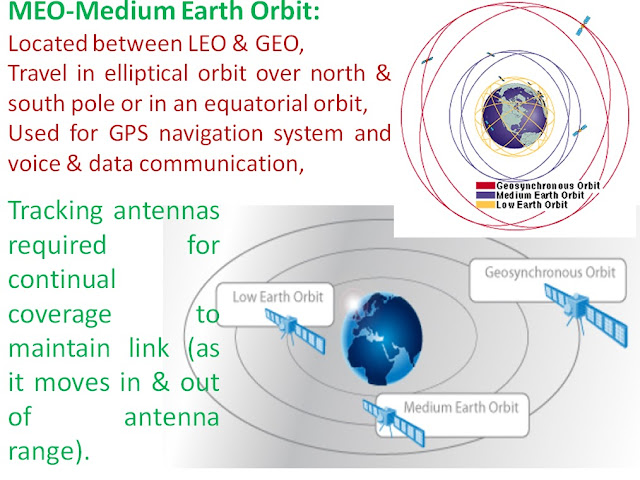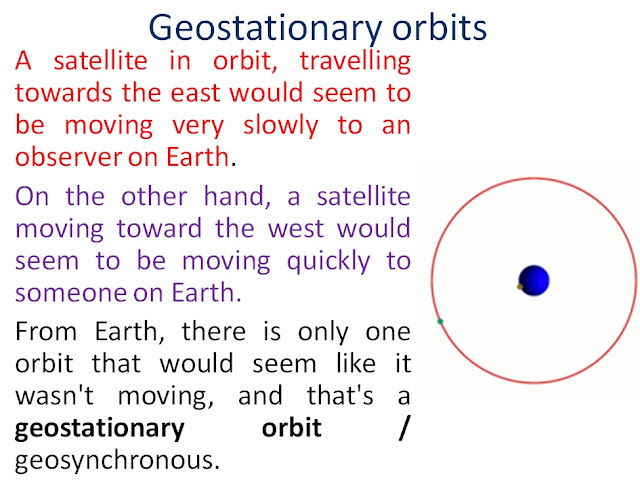Meaning of Satellite & Basic concepts:
Satellite:
"satellite is object which rotates around some body due to the effect of gravitational forces" .
OR
"A satellite is an object which has been placed into orbit by human endeavor" .
•A satellite communications system uses satellites to relay radio transmissions between earth terminals.
•The two types of communications satellites are ACTIVE and PASSIVE.
•A passive satellite only reflects received radio signals back to earth.
•An active satellite acts as a REPEATER; it amplifies signals received and then retransmits them back to earth.
•This increases signal strength at the receiving terminal to a higher level than would be available from a passive satellite.•A typical operational link involves an active satellite and two or more earth terminals.•One station transmits to the satellite on a frequency called the UP-LINK frequency.
•The satellite then amplifies the signal, converts it to the DOWN-LINK frequency, and transmits it back to earth.
•The two types of communications satellites are ACTIVE and PASSIVE.
•A passive satellite only reflects received radio signals back to earth.
•An active satellite acts as a REPEATER; it amplifies signals received and then retransmits them back to earth.
•This increases signal strength at the receiving terminal to a higher level than would be available from a passive satellite.•A typical operational link involves an active satellite and two or more earth terminals.•One station transmits to the satellite on a frequency called the UP-LINK frequency.
•The satellite then amplifies the signal, converts it to the DOWN-LINK frequency, and transmits it back to earth.
History of Satellite in Short Timeline:
1957-1990 :
•USSR launched the first artificial earth satellite, Sputnik in 1957.
•US launched the first GEO satellite, Relay-1 in 1962.
•First trans pacific TV traffic distribution in 1963.
•First satellite packet radio network in 1970. [ALOHA (Application Layer Optimization and High Availability) Net].
•Satellites connected the American continent and UK in 1975 [SATNET (satellite network)].•First demonstration of interconnection between ARPANET (Advanced Research Projects Agency network), SATNET (satellite network) and PRNET (packet radio network ) in 1977.•First TCP (Transmission Control Protocol) specification was released in 1982.•VSAT (very small aperture terminal) technology (1980-1990): Ku band (uplink 14ghz, downlink 12ghz). Both way communication capability. 1.8m-2.4m dish size.Point to point communication. Star topology.Mesh topology.
1990-till now:
•Big success in the digital TV broadcasting-
DirecTV, B-Sky-B [British Sky Broadcasting (TV broadcaster)], SKY-perfec-TV [Japanese company for direct broadcast satellite (DBS) service], etc.
•One way communication platform based on MPEG (Motion Picture Expert's Group) 2 system.
•UDLR (Uni-directional Link Routing)
•TCPSAT(TCP over satellite)
•Satellite link as one-way communication: UDLR
•Satellite link as a two-way communication: DVB-RCS (Digital Video Broadcasting - Return Channel via Satellite)
Satellite Communication System:
 |
Orbit types
|
 |
| Satellite communications system |
•The basic design of a satellite communications system depends to a great degree upon the characteristics of the orbit of the satellite.
•A special type of orbit is a SYNCHRONOUS ORBIT, In which the period (time required for one revolution) of the orbit is the same as that of the earth.
•An orbit that is not synchronous is called ASYNCHRONOUS. A period of orbit that approaches that of the earth is called NEAR SYNCHRONOUS (sub-synchronous).
|
Classification of orbit by Altitude:
 |
| MEO-Medium Earth Orbit GEO-Geostationary Orbit: |
 |
| GEO-Geostationary Orbit |
 |
| Earth turns from west to east |
Geostationary orbits :

